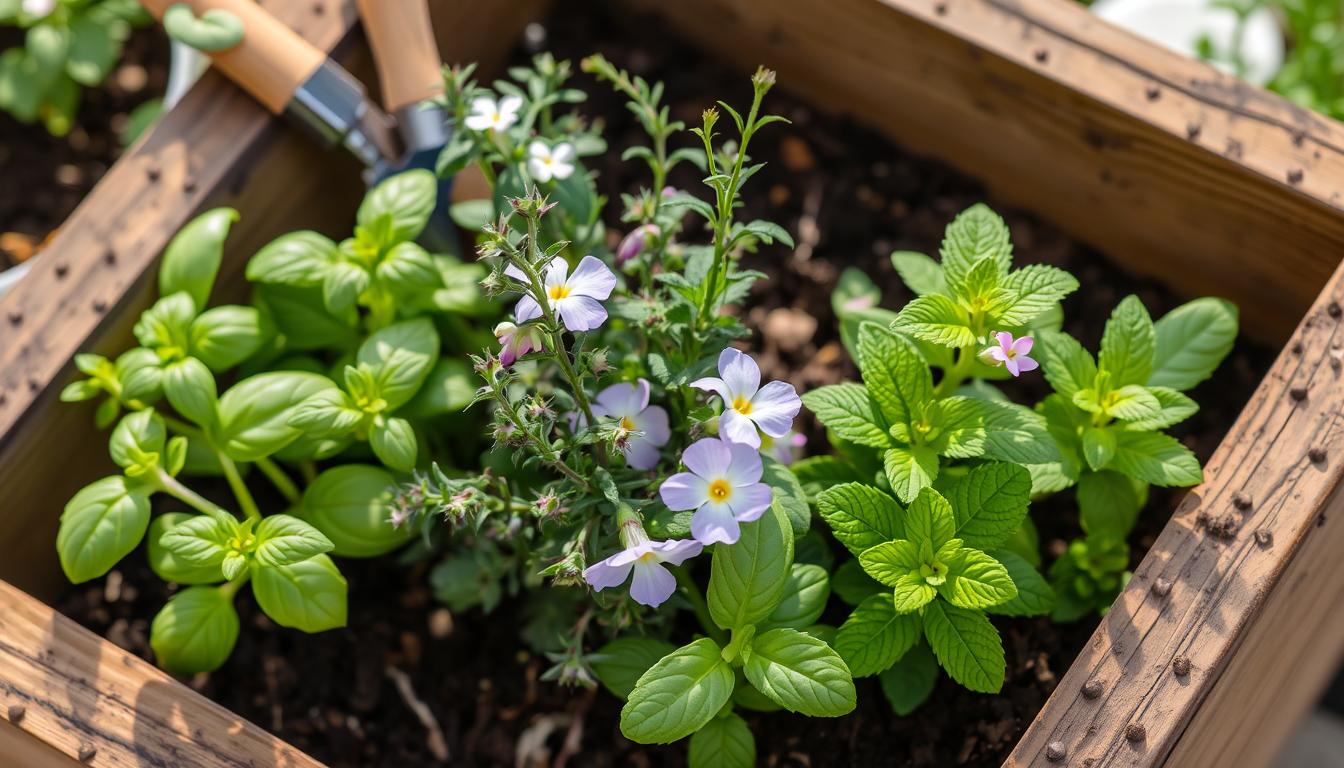Starting a mini herb garden is a great way to begin with kitchen gardening. It’s perfect for small spaces like patios, porches, or balconies. Herbs are simple to care for and harvest, making them ideal for beginner gardeners.
You can grow herbs from seeds or buy healthy plants from local nurseries. It’s best to avoid big box stores. They often use synthetic fertilizers or fungicides on their plants. Instead, choose local nurseries or grow your own from cuttings.
Key Takeaways
- Mini herb gardens are ideal for small spaces and beginner gardeners
- Herbs can be grown from seeds or purchased as starter plants
- Avoid big box stores and opt for local nurseries or propagate cuttings
- Herbs like rosemary, mint, chives, and oregano are considered easy to grow
- Herbs can provide a continuous harvest and reduce reliance on store-bought herbs
Essential Planning for Your Mini Herb Garden
Starting a DIY herb garden requires careful planning. You can grow herbs in a small balcony or backyard. The first step is to pick the right spot and know how much space your herbs need.
Choosing the Perfect Location
Most herbs love sunlight, needing 4-5 hours of direct sun daily. But, some like chervil and parsley can handle partial shade. Think about your spot’s sun and pick herbs that fit.
Understanding Space Requirements
The size of your garden affects which herbs you can grow. Mint and chives spread a lot, so they’re good for containers. Basil and parsley grow close together, but rosemary and thyme need more room.
Gathering Necessary Supplies
To start your herb garden, you’ll need:
- Peat-free, multi-purpose compost
- Containers or raised beds with good drainage
- Hand trowels and basic gardening tools
- Clear plastic bags for mini greenhouses (optional)
- Small pots or repurposed containers for seed starting
With good planning and the right tools, you’ll have a lush organic herb garden in no time.
Best Herbs for Beginners to Grow
Starting an herb garden is exciting and rewarding, especially for beginners. There are many herbs to choose from. You can pick from perennial herbs that grow all year or annuals for seasonal harvests.
Perennial Herbs for Year-Round Growth
Perennials like rosemary, mint, chives, and oregano are great for beginners. They grow back every year and can handle cold weather. They need little care once they’re set up.
Annual Herbs for Seasonal Harvests
Annual herbs like basil, parsley, cilantro, and dill are also good for beginners. They grow from seed and finish their life in one season. They need more care but let you try different flavors and textures.
Low-Maintenance Herb Options
Chives are perfect for those who want easy-to-grow herbs. They do well in many soils and need little care. Their green leaves and purple flowers add beauty to any garden.
Choose a mix of perennial and annual herbs for a constant supply of fresh herbs. With the right approach and knowledge, your mini herb garden will thrive.
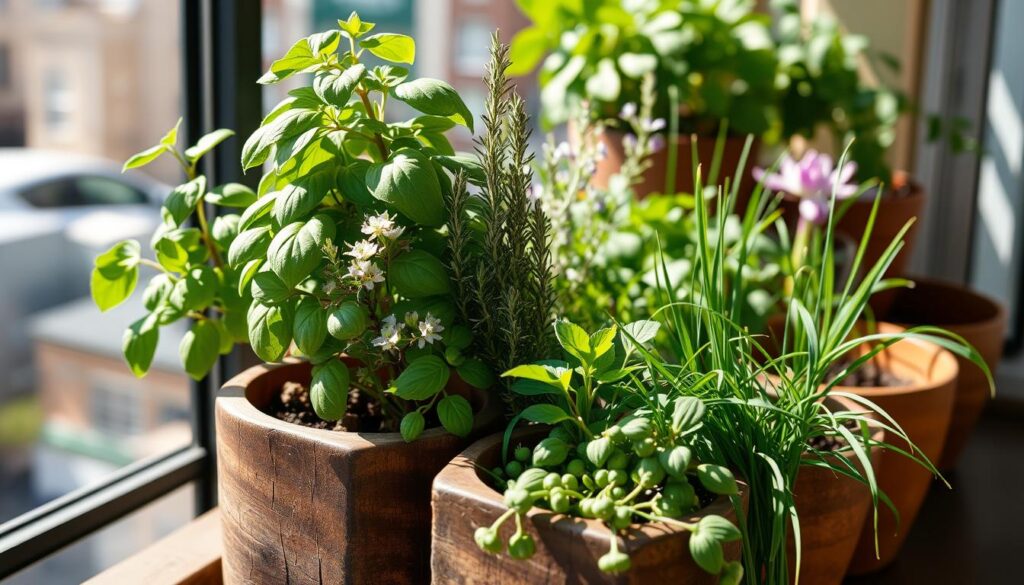
A Step-by-Step Guide to Creating a Mini Herb Garden
Creating a mini herb garden is rewarding and practical. It lets you have fresh kitchen herbs always ready. This guide is for both experienced gardeners and beginners. It will help you create a thriving herb garden design in small spaces.
Start by picking the right containers or a garden bed. Fill them with good, peat-free compost. Make it firm by gently tamping it down. For seeds, spread them out and cover with compost. A clear plastic bag can help seeds germinate faster by creating a mini greenhouse.
For potted herbs, plant them about a hand’s width apart. Water well after planting and label each herb. Group herbs by their water and sunlight needs for easier care.
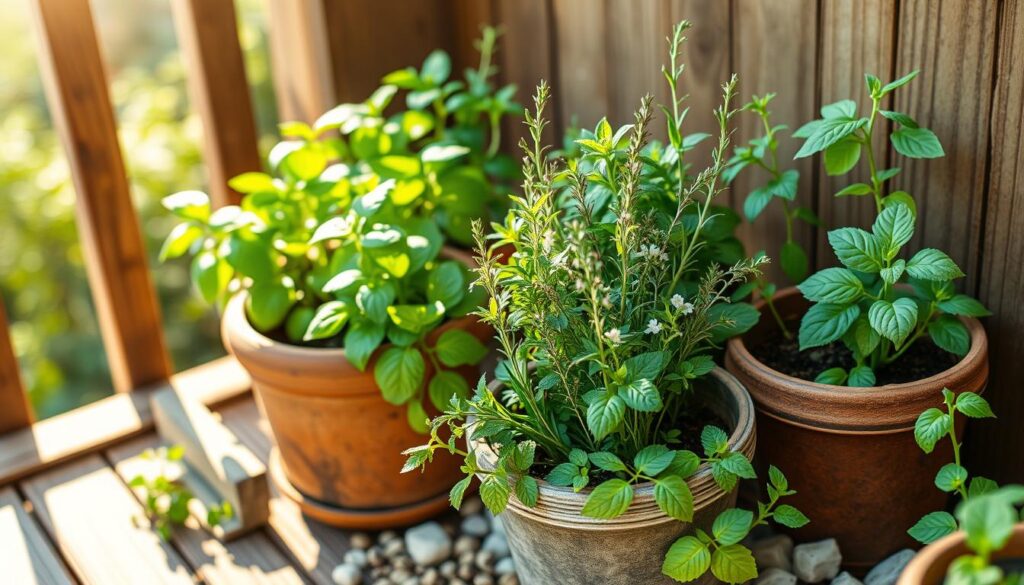
Most herbs love well-drained soil and bright, indirect sunlight. Make sure your containers or garden beds get enough light. With care and patience, your mini herb garden will give you a lot of fresh, tasty ingredients.
Essential Care and Maintenance Tips
To grow a thriving mini herb garden, you need to pay attention to a few key things. Whether you’re new to sustainable gardening or have been doing it for a while, learning how to care for your herbs is important. It helps you enjoy a lot of tasty, fragrant homegrown produce.
Watering Guidelines
Aromatherapy herbs like most plants prefer soil that drains well and don’t need too much water. Water your herbs when the soil feels dry, usually once a week for plants in pots. Watch out for basil, as it doesn’t like too much water. Water basil during the day to prevent the soil from getting too wet.
Pruning and Harvesting Techniques
Pruning and harvesting your herbs regularly helps them grow better and taste better. Cut off leaves or sprigs as you need them, but make sure to leave enough for the plant to keep growing. Let some herbs, like lavender and oregano, bloom to attract bees. Bees help with pollination and pest control.
Pest Control Methods
To keep pests away from your kitchen gardening, use organic and sustainable methods. Try companion planting, where you place certain herbs and plants together to keep pests away. You can also pick off insects or use natural, safe repellents to keep your garden healthy.
By following these care and maintenance tips, your sustainable living herb garden will thrive. It will give you a steady supply of fresh, tasty herbs for cooking and aromatherapy.
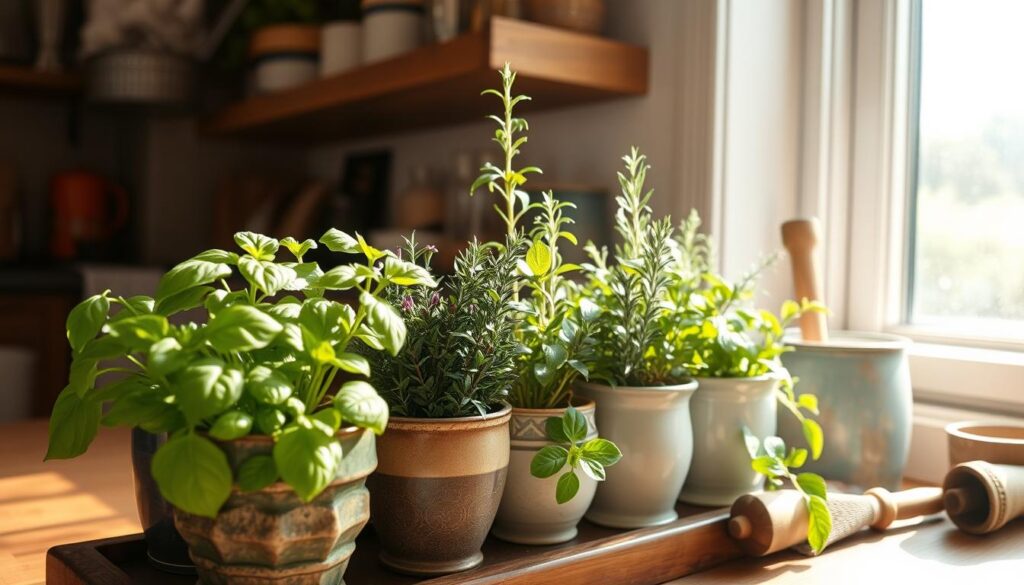
Common Mistakes to Avoid When Growing Herbs
Growing herbs indoors can be rewarding but comes with challenges. To make sure your plants thrive, avoid these common mistakes.
One big issue is poor lighting. Herbs need at least 6-8 hours of direct sunlight each day. Plants like basil, cilantro, and mint are very picky about light. Make sure your herbs get plenty of sunlight.
- Dill, coriander, parsley, lavender, rosemary, and basil are among the 15 herbs identified as challenging to grow indoors.
- Compact size, tolerance to lower light conditions, continuous harvest, and enjoyment of moderate room temperatures are attributes of ideal herbs for indoor growth.
Another mistake is overwatering. Too much water can cause herbs to rot and look wilted. Use a container that’s 1.5 to 2 times the size of the plant’s roots. Stick to a regular watering schedule.
Don’t forget to prune and ensure airflow. Pruning helps herbs grow bushy and increases yields. Also, make sure they have enough space and air to prevent diseases.
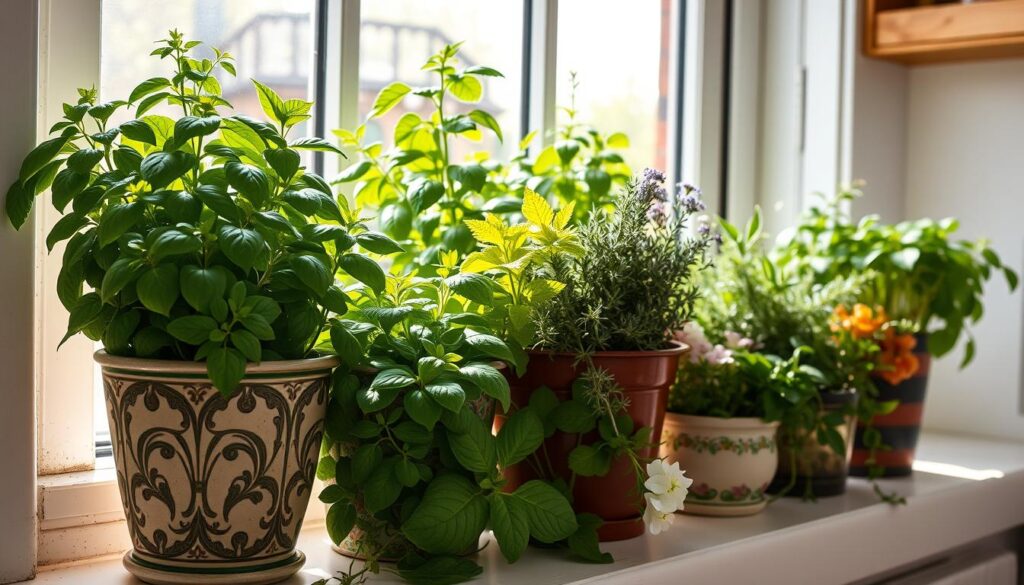
By avoiding these common mistakes, you’ll grow a healthy indoor herb garden. It will give you plenty of fresh herbs for cooking.
Conclusion
Creating a mini herb garden is a fun and rewarding experience. It gives you fresh, flavorful culinary herbs for cooking and for making scents. It’s a great way to teach kids about organic gardening and living green.
By following this step-by-step guide to creating a mini herb garden, you can grow many herbs in small spaces. This makes your cooking better and helps the planet. Try out different herbs and enjoy growing your own food.
Growing your own herbs means you always have tasty ingredients ready in your kitchen. You can choose from herbs that grow all year or ones that are seasonal. This guide helps you grow a successful mini herb garden.
With the right care, your herbs will grow well and give you lots of food. Starting your herb garden is a chance to connect with nature and learn new things. It’s also very rewarding to use your own fresh herbs.
So, let your creativity shine and turn your small space into a beautiful herb garden. It will make your cooking better and help you live more sustainably.
FAQ
Q: What are the essential planning steps for creating a mini herb garden?
A: When planning your mini herb garden, pick a spot that gets the right sunlight. You’ll need peat-free compost, containers with holes, and tools like hand trowels. Don’t forget clear plastic bags for mini greenhouses.
Q: Which herbs are best for beginners to grow?
A: Beginners should start with easy herbs like rosemary, mint, chives, and oregano. Annuals like basil, parsley, cilantro, and dill are also good choices. Chives are especially easy to grow.
Q: How do I create a mini herb garden step-by-step?
A: To start, fill containers with peat-free compost and plant your herbs. Make sure they’re not too close together. Water well after planting and label each herb. Plant herbs that need similar care together.
Q: What are the essential care and maintenance tips for a mini herb garden?
A: Most herbs don’t need a lot of water, so check the soil before watering. Water once a week for potted herbs. Prune and harvest regularly to help them grow. Use organic pest control like companion planting or handpicking.
Q: What common mistakes should I avoid when growing herbs?
A: Avoid overwatering, especially for Mediterranean herbs. Don’t plant mint with other herbs as it can overwhelm them. Also, watch out for too much sun on basil, parsley, and coriander, as it can make them seed too early.


